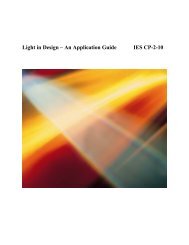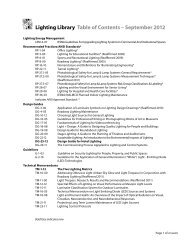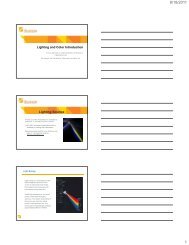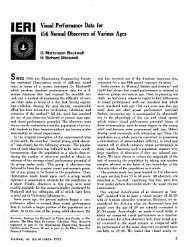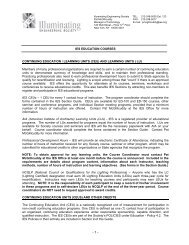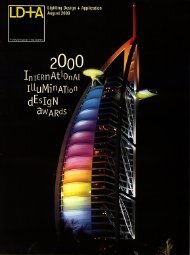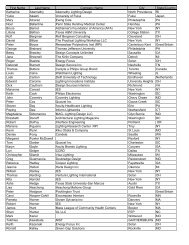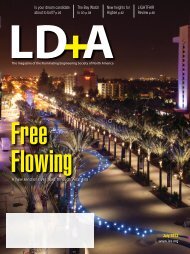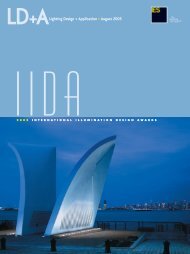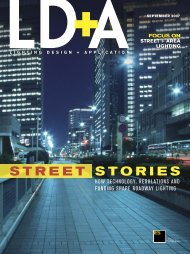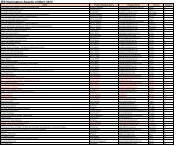faces of the future - Illuminating Engineering Society
faces of the future - Illuminating Engineering Society
faces of the future - Illuminating Engineering Society
Create successful ePaper yourself
Turn your PDF publications into a flip-book with our unique Google optimized e-Paper software.
UPDATES<br />
LRC Specifier Report<br />
NLPIP Study Questions Effectiveness <strong>of</strong><br />
LED and Induction Streetlights<br />
LED and induction streetlights may be popular alternatives<br />
to traditional high-pressure sodium (HPS) streetlights,<br />
but <strong>the</strong>y may not be better options. According<br />
to a new study from The National Lighting Product<br />
Information Program (NLPIP) at Rensselaer Polytechnic<br />
Institute’s Lighting Research Center, it may take more<br />
LED and induction streetlights than HPS streetlights to<br />
meet necessary design criteria.<br />
In <strong>the</strong> study, NLPIP performed photometric<br />
evaluations <strong>of</strong> 14 streetlights<br />
that used ei<strong>the</strong>r HPS, pulse-start metal<br />
halide (PSMH), induction lamps or LED<br />
modules. It analyzed <strong>the</strong> streetlights for<br />
light output and distribution, energy use,<br />
spectral effects on visual performance,<br />
discomfort glare, and economic factors.<br />
The streetlights were evaluated as part<br />
<strong>of</strong> installations that meet <strong>the</strong> lighting criteria<br />
as defined in <strong>the</strong> American National<br />
Standard Practice for Roadway Lighting, ANSI/IESNA<br />
RP-8-00 (R2005), for a simulated one-mile stretch <strong>of</strong> collector<br />
roadway (a road servicing traffic between local<br />
and major roadways).<br />
The NLPIP found that if LED or induction streetlights<br />
replaced <strong>the</strong> pole-mounted HPS streetlights, it would take<br />
twice as many <strong>of</strong> <strong>the</strong> streetlights to meet <strong>the</strong> lighting criteria<br />
as defined in RP-8-00. Additional findings included:<br />
• On average, <strong>the</strong> LED streetlights and <strong>the</strong> induction<br />
streetlight could be spaced only about one-half <strong>the</strong><br />
distance <strong>of</strong> <strong>the</strong> HPS and PSMH streetlights and still<br />
meet <strong>the</strong> RP-8 lighting criteria. If an HPS or PSMH<br />
streetlight system just meeting RP-8 is replaced with<br />
<strong>the</strong> LED or induction streetlights tested in this report<br />
on a one-for-one basis, <strong>the</strong> streetlight system will<br />
not meet RP-8.<br />
• The life-cycle cost per mile is dominated by <strong>the</strong> initial<br />
and installation cost <strong>of</strong> <strong>the</strong> poles, not <strong>the</strong> initial cost<br />
<strong>of</strong> streetlights or any potential energy or<br />
maintenance cost savings. Because <strong>of</strong> <strong>the</strong><br />
narrower pole spacing required to meet<br />
RP-8, <strong>the</strong> life-cycle cost <strong>of</strong> <strong>the</strong> LED streetlights<br />
tested for this study is up to twice that<br />
<strong>of</strong> <strong>the</strong> HPS and PSMH streetlights tested.<br />
However <strong>the</strong> study acknowledges that:<br />
• On average, <strong>the</strong> LED streetlights require<br />
between 1 percent and 10 percent less<br />
power per mile than <strong>the</strong> HPS streetlights<br />
tested in staggered and single-sided layouts,<br />
respectively. On average, <strong>the</strong> LED<br />
streetlights require between 8 percent and 24 percent<br />
less power than <strong>the</strong> PSMH streetlight tested in singlesided<br />
and staggered layouts, respectively.<br />
• At <strong>the</strong> illuminance levels typical <strong>of</strong> collector roadways,<br />
power requirements for “white light” sources<br />
are 3 percent to 19 percent lower than HPS sources<br />
based on models <strong>of</strong> mesopic photometry.<br />
The NLPIP’s finding were published in a Specifier<br />
Report, which is available online at www.lrc.rpi.edu/<br />
nlpip/publications.asp.<br />
NALMCO Certification<br />
More Letters in <strong>the</strong> Alphabet Soup<br />
Move over LEED, <strong>the</strong> newest sustainable certification program is all about lighting. The interNational Association<br />
<strong>of</strong> Lighting Management Companies (NALMCO) has announced its new certification—Certified Sustainable Lighting<br />
Consultant (CSLC)—<strong>the</strong> industry’s first “sustainability certification” for lighting pr<strong>of</strong>essionals. The certification can be<br />
earned through an exam that tests 10 areas <strong>of</strong> knowledge, touching on such topics as materials, recycling, transportation,<br />
light pollution, manufacturing and o<strong>the</strong>r environmental impacts. Only individuals who are already Certified<br />
Lighting Management Consultants, ano<strong>the</strong>r NALMCO certification, are eligible to take <strong>the</strong> exam.<br />
16 www.ies.org



